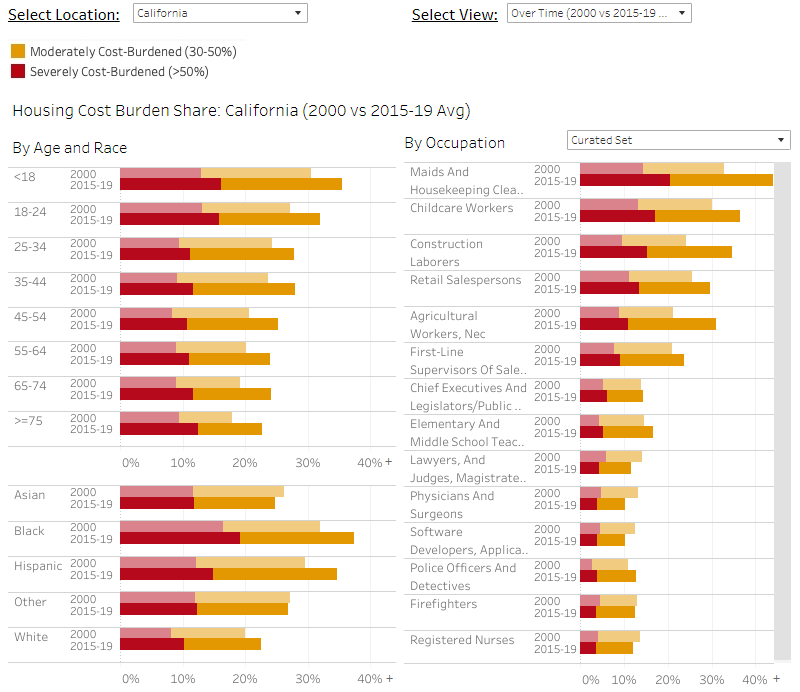HOPE Tool: Data and Dashboard for Understanding California’s Housing Crisis
Published On September 11, 2023
Issi Romem, a Terner Affiliate and founder of MetroSight, has created a new online tool to easily access local, regional, and state socio-economic data for California. The Housing, Occupations, People and Economics (HOPE) Tool aggregates public data from federal and publicly available private-sector databases to allow users to quickly assess and interpret changes in socio-economic and housing characteristics across California. The HOPE Tool also features an interactive dashboard providing information specifically on income and housing affordability.
For general users, the dashboard provides an easy way to analyze who is bearing the brunt of California’s housing crisis. The dashboard reports on median household incomes and their distribution, as well as housing type and tenure (renters vs owner-occupants with and without a mortgage), housing cost-burdens, and price-to-income ratios. The dashboard visualizes how these metrics have changed over time, and how they vary across age groups, race/ethnicity, and by occupation. It also allows the user to see the data at different geographic scales, including by State Senate and Assembly district.
To illustrate the tool’s power, we used it to examine housing cost burdens across the state. (Figure 1). Using the tool, we were able to see rising housing cost burdens for essential workers, like those who provide childcare and housekeeping services. Nearly one in two (44 percent) people who work as maids and housekeepers were paying more than 30 percent of their income for housing prior to the pandemic, a significant increase (11 percentage points) since 2000. The disproportionate impact of the housing crisis on Black and Hispanic households also stands out clearly in the tool. Dashboard users who want a more streamlined visualization can select or deselect different categories, and download the results.
Figure 1: HOPE Tool Interactive Dashboard Snapshot: Housing Cost Burden, California
 Source: Issi Romem, MetroSight, Income and Housing Affordability Dashboard
Source: Issi Romem, MetroSight, Income and Housing Affordability Dashboard
For users who want to dig deeper into the data, the accompanying datafiles allow researchers to explore housing issues in more detail, such as the growing importance of wealth for attaining homeownership, how the elderly are faring in an increasingly precarious housing market, and which occupations face affordability challenges across the state. One of the major strengths of the HOPE Tool is that it provides data on Area Median Income (AMI) bands for all the different indicators; this means that researchers don’t need to go through the additional step to calculate AMIs for various regions or types of occupations on their own. The tool also aggregates the Census’s microdata (which is provided at the Public Use Microdata Area (PUMA) level) to different geographic scales, also saving time and an extra analytical step. For those who want to learn more about the underlying data, the HOPE Tool includes detailed descriptions of the data and methodology.
The goal of the HOPE tool is to enable advocates, academics, policymakers, and the general public to more readily access data that can help to shed light on the complex housing challenges facing people across the state. It connects housing and labor market data in critical ways, highlighting the links between occupations, wages, and housing cost burdens, and showing how those links vary across California’s diverse regions. With the HOPE tool, advocates, policymakers and the public at large can better understand the dimensions of the affordability crisis within their own communities and can more readily effectuate policies that can help to promote housing stability and affordability.





